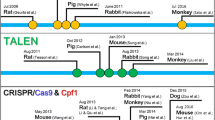Abstract
A transgenic animal can be defined as an organism that has undergone a stable modification of genotype as a result of genetic manipulation. Such animals are being increasingly employed as research and development tools by both academic and commercial institutions. The primary methods by which transgenic animals can be generated will be described. The relative merits of the approaches will be illustrated, as will their potential use in the discovery and development of novel therapeutic entities.
Similar content being viewed by others
References
R. Jaenisch,Transgenic animals. Science240, 1468–1474 (1988).
A. D. Miller,Human gene therapy comes of age. Nature357, 455–460 (1992).
N. Sarvetnick, D. Liggitt, S. L. Pitts, S. E. Hansen and T. A. Stewart,Insulin-dependent diabetes mellitus induced in transgenic mice by ectopic expression of class II MHC and interferon-γ. Cell52, 773–782 (1988).
R. L. Tepper, D. A. Levinson, B. Z. Stranger, J. Campos Torres, A. K. Abbas and P. Leder,IL-4 induces allergic-like inflammatory disease and alters T cell development in transgenic mice. Cell62, 456–467 (1990).
R. E. Hammer, S. D. Maika, J. A. Richardson, J.-P. Tang and J. D. Taurog, Spontaneous inflammatory disease in transgenic rats expressing HLA-B27 and humanβ 2 m: An animal model of HLA-B27-associated human disorders. Cell63, 1099–1112 (1990).
P. S. Jat, M. D. Noble, P. Ataliotis, Y. Tanaka, N. Yannoutsos, L. Larsen and S. Kiousis,Direct derivation of conditionally immortal cell lines from an H-2K b -tsA58 transgenic mouse. Proc. Natl. Acad. Sci.88, 5096–5100 (1991).
J. A. Gossen, W. J. F. de Leeuw, C. H. T. Tan, E. C. Zwarthoff, F. Berends, P. H. M. Lohman, D. L. Knook and J. Vug,Efficient rescue of integrated shuttle vectors from transgenic mice: A model for studying mutations in vivo. Proc. Natl. Acad. Sci.86, 7971–7975 (1989).
S. W. Kholer, G. S. Provest, A. Fieck, P. L. Kretz, W. O. Bullock, J. A. Sorge, D. L. Putman and J. M. Short,Spectra of spontaneous and mutagen-induced mutations in the IacI gene in transgenic mice. Proc. Natl. Acad. Sci.88, 7958–7962 (1991).
Author information
Authors and Affiliations
Rights and permissions
About this article
Cite this article
Harris, S., Davis, N.K., Jowett, M.I. et al. Transgenic animals as tools in drug development. Agents and Actions 38 (Suppl 2), C57–C58 (1993). https://doi.org/10.1007/BF01991136
Issue Date:
DOI: https://doi.org/10.1007/BF01991136




